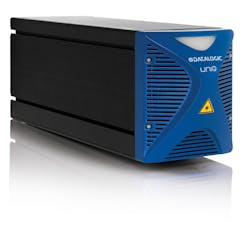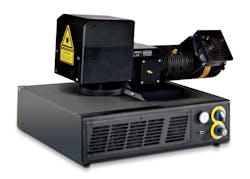Four reasons to choose fiber lasers
CHRIS OGDEN
More companies than ever before are investing in fiber lasers. While the automotive industry was undoubtedly the early adopter, this relatively new solution is being snapped up across the board and when you consider the advantages, it's easy to see why.
1. Extra speed
The sheer speed of fiber laser markers makes them the first choice for customers looking to increase efficiency. They're the fastest laser marking technology at their wavelength, delivering marking times of less than one second for some applications. While older, more established laser technology is available—including diode-pumped solid-state (DPSS) lasers, lamp-pumped lasers, and carbon dioxide (CO2) lasers—none can beat a fiber laser for combined mark speed and quality.
This means fiber lasers can break new ground. For example, one of Laser Lines' customers is an automotive component manufacturer that needs to mark serial codes exceptionally fast—in under half a second—which wouldn't be possible with any other type of laser.
How do they achieve their speed? They're better configured for speed and aggression, and are also more powerful. DPSS laser systems, for example, rarely have a power rating over 20W, whereas fiber laser marking systems typically deliver up to 50W. These high power levels are crucial for both speed and depth of marking.
2. Energy efficiency
Despite being faster, fiber lasers are energy-efficient compared to the alternatives. Not only does this result in reduced power consumption, but it also helps make the system simpler, smaller, and more reliable.
Fiber laser technology uses basic air cooling rather than an additional chiller unit, which would be costly and cumbersome. With many businesses finding both cash and floor space in short supply, compact and efficient fiber laser marking solutions are proving to be the right fit.
The automation industry, for example, is adopting fiber lasers to help build manufacturing lines, and a system called the UniQ is invaluable here (FIGURE 1). It's an IP65-approved single unit laser system, with the laser head controller and PC in one box, making it compact and easy to integrate without messy cables.
3. Long life
The life expectancy of a fiber laser far exceeds that of other laser solutions. In fact, the diode module in a fiber laser typically last three times longer than other technologies. Most lasers have a life of around 30,000 hours, which typically equates to about 15 years' use.
Fiber lasers have an expected life of around 100,000 hours, which means about 45 years' use. Saying that, will companies still be using the same fiber laser in 45 years? I doubt it! Regardless, this option does deliver an impressive return on investment.
4. Laser power
Because of the duration of power delivery by the technology, fiber laser marking solutions are ideal for deep marking. Rather than delivering a continuous stream of energy, fiber lasers deliver extended pulses. But, while still pulsing at up to 200,000 times per second, fiber lasers extend their pulse just enough to avoid those damagingly high peaks of energy. This means they deliver energy over a longer period of time, which is ideal for marking deep, durable marks. A good practical example is in manufacturing automotive brake systems.
So, what's the future for fiber lasers? With fiber lasers already being so outstandingly energy-efficient, and at a time when companies need to find energy savings, we'll continue to see them soar in popularity, despite not always being the best solution.With fiber lasers, the benefits can be blinding. But what users think they want and what actually they need can be two different things. While there are compelling reasons to choose fiber lasers and the trend is ever more bucking in their direction, it's worth remembering that sometimes the older alternatives offer a better solution. Lamp pump lasers are still great for laser welding; the wavelength of light from CO2 lasers is still great for laser cutting certain materials; and, even when it comes to marking, other laser technologies can perform better with plastics (FIGURE 2). It's all about the task at hand.
CHRIS OGDEN ([email protected]) is Manager, Lasers & Accessories at Laser Lines, Beaumont Close, Banbury, England; www.laserlines.co.uk.

